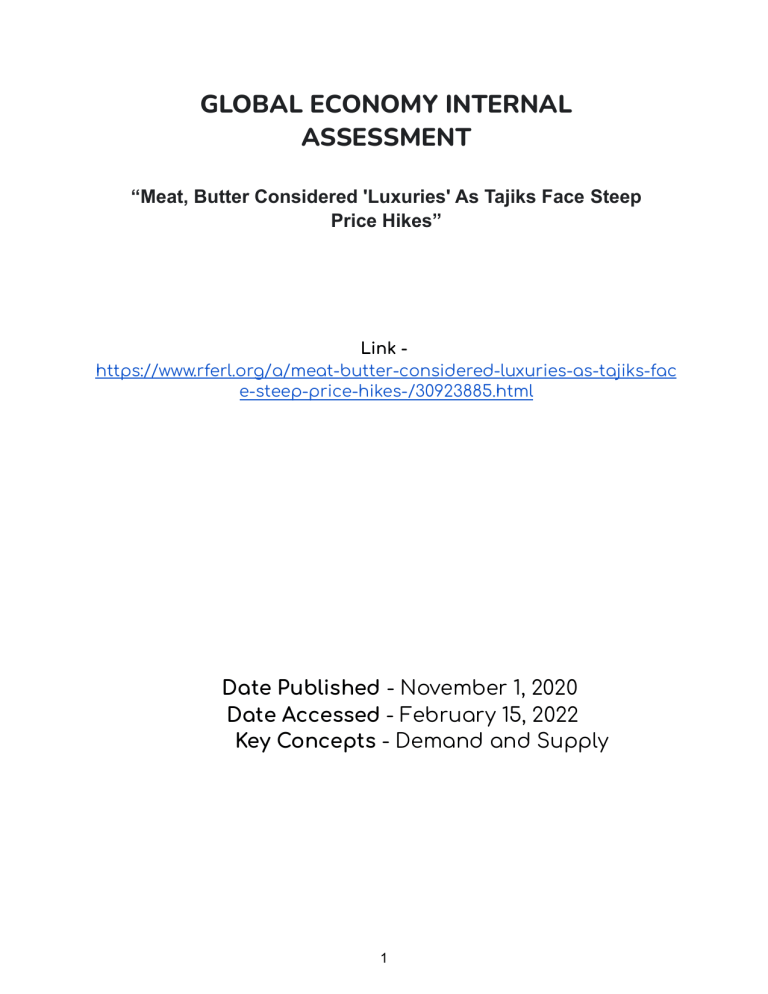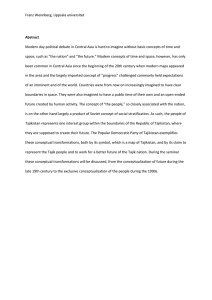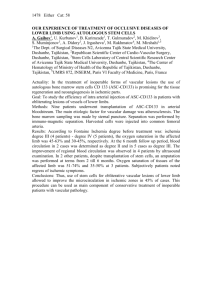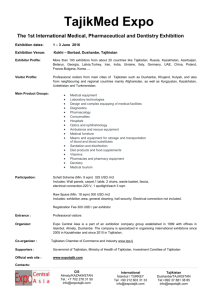
GLOBAL ECONOMY INTERNAL ASSESSMENT “Meat, Butter Considered 'Luxuries' As Tajiks Face Steep Price Hikes” Link https://www.rferl.org/a/meat-butter-considered-luxuries-as-tajiks-fac e-steep-price-hikes-/30923885.html Date Published - November 1, 2020 Date Accessed - February 15, 2022 Key Concepts - Demand and Supply 1 ARTICLE: Ozoda is making mantu, a traditional Tajik dumpling dish for dinner, but instead of meat she fills the dough wrappings with chopped onion and potatoes.“My children complained about eating pumpkin mantu every time, so I’m putting potatoes in this time -- we can’t afford meat anymore,” Ozoda, a mother of four in Tajikistan’s Sughd Province said “We survive on bread, pasta, pumpkin, and potatoes.” Breakfasts mostly consist of bread and tea with sugar, with the exception of “the salary day” when the schoolteacher receives her wages and the family “splurges on eggs and sausages for the kids.” “Butter? Butter is a luxury I can’t even think about. I don’t turn to that side of the bazaar anymore,” said Ozoda. “People have a lot less money this year.” Tajikistan, the poorest country in Central Asia, is experiencing steep price hikes on food that have put a further strain on a population that is already struggling to put adequate supplies on their tables. 2 It’s forcing many families to forego important nutritious food and only purchase basic staples, an alarming trend in a country where an estimated one-third of the population faces malnutrition. According to the World Food Program, 47 percent of the people in Tajikistan live on less than $1.33 a day and an estimated 30 percent of the population are malnourished. The coronavirus pandemic has sent food prices soaring in many countries, as it forced border closures, restricted transport networks, and disrupted import and export systems. Tajikistan has been hit particularly hard. Millions of households in the remittances-dependent country saw their main source of income vanish as many migrant workers were unable to travel to Russia and Kazakhstan this year. According to the Labor Ministry, the number of Tajik migrants who went abroad for work in 2020 decreased by 57 percent compared to last year. Even those who managed to go have had their earnings dwindle due to pandemic restrictions in the host countries. In April, the government ordered farmers to grow more vegetables and grains instead of inedible crops, and to try to get three rounds of harvests to help ensure food security in the country. Officials also called on the population to use their land plots and backyards as well as greenhouses to grow vegetables. Households were urged to harvest and store a two-year food supply. 3 Dushanbe also introduced a ban on the export of some agricultural products, including grains, potatoes, legumes, eggs, and meat. But with 93 percent of its lands covered by mountains, it’s a tall order for Tajikistan to become self-reliant in producing food for its 9.3 million inhabitants. A study by the World Food Program also found that some 97 percent of Tajikistan’s arable land is subject to soil degradation. Tough Choices In mid-October, RFE/RL’s Tajik Service reported that prices for vegetable oil and sugar went up by as much as 30 percent in many markets in the capital, Dushanbe, where a smaller uptick was recorded in the cost of other staples, such as eggs, meat, and rice. The price of sugar went up from $0.6 to $1, while the cost of vegetable oil rose from $1.16 to $1.55 per kilo. Such price increases make a big difference to ordinary households in Tajikistan, where the average monthly salary is about $160 per month and the average pension for retirees is $33. Those figures include a recent across-the-board increase by the state. 4 The majority of Tajiks, including city dwellers, buy their groceries in bazaars where prices are cheaper than in supermarkets. In such bazaars it is customary for buyers to also haggle for lower prices. Food prices do vary somewhat in different regions and sometimes even in different markets of the same city. Customers complain that prices constantly fluctuate -- “different prices every week” -- and that they often go up without notice or explanation. Vegetable and fruit prices often go down during the prime part of the harvest season. Figures provided by the state statistics agency indicate that the average cost of rice, flour, all types of meat, cooking oil, eggs, sugar, and tea in Dushanbe were higher in October compared to the previous month. At the same time, the cost of milk, wheat, and beans remained stable, while the price of potatoes and cabbage went down during the same period. According to the statistics committee, in the week starting October 19 the average price of beef in Dushanbe was $5 per kilogram, black tea $4.6, rice $1.3, and flour $0.47 per kilo. A liter of milk cost $0.45 and a pack of 10 eggs cost about $1. On the streets of Dushanbe, some customers told RFE/RL’s Tajik Service that they had noticed the higher prices and the new costs were not commensurate with people's budgets,particularly those facing unemployment or working in low-paid professions. 5 Every somoni counts in a country where the gross domestic product per capita was only $877 before the pandemic struck earlier this year. Dushanbe resident Rustam Nasriddinov said he no longer knows how to get by with his paltry salary amid the higher prices. “Prices rise every day, by one somoni, two simonis. I don’t know what the reason is. I just found out that a 5-kilo pack of sunflower oil now costs $7.2 in Dushanbe,” Nasriddinov told RFE/RL. Many customers say they are increasingly turning to cheaper and unhealthier options, such as buying cotton-seed oil instead of sunflower oil for cooking. Others are cutting back even on unaffordable “luxuries.” State Wage Increase The government raised the salaries of public-sector workers and pensions by 15 percent in September and introduced an additional pay raise and bonuses for health-care workers. Officers and other law-enforcement sector workers, the judiciary system, and the military saw their wages increase by 10 percent. But many people say more needs to be done to help people by investing in the resources needed to create jobs and greater income generation in the country. Some residents even suggest that authorities should open subsidized food stores to help protect the most vulnerable until the situation improves. “The government needs to listen to the people, real people,” said a journalist from the southern Kulob region who asked for anonymity for fear he could be punished for speaking critically. “You can see an abundance of food in the bazaars and yes, you see people buying stuff, some even not looking at the prices. But that is not the majority.” He concluded: “Anyone who says the majority of Tajiks are eating an adequate amount of food, is detached from reality and has no idea what’s going on.” 6 Analysis According to the article, the pandemic affected supply chains in Tajikistan, resulting in price increases on a variety of staples. As a result, this commentary analyzes the situation based on supply and demand - how much a commodity firm is willing to produce and how much a consumer will pay at various prices; PED - the responsiveness of a product's quantity demanded to price changes; and price ceiling the maximum price a producer can charge for its products set by the government. Tajikistan is experiencing rising food prices due to the decrease in supplies from abroad. Sugar's price has risen to $1 from $0.6 a kilo, according to the article's 11th highlighted paragraph. This diagram shows the sugar market, which also applies to other food staples with rising prices. Assume the equilibrium point a was reached before the pandemic at $0.6 for Q1 sugar. Due to supply cuts from outside, the supply curve has shifted inwards 7 (S1→S2).This has caused a movement along the S2 curve, resulting in the current equilibrium point c, where the shortage has been eliminated at the cost of higher price ($1) and lower demand (Q3) of sugar on the market. Also, since necessary foods are primary commodities, a price change will lead to a much smaller change in demand. This is mainly because they are necessities and have few or no substitutes.However, these high prices might overburden consumers already suffering from unemployment and low incomes since the borders to Russia and Kazakhstan were closed, according to the article’s 7-8th highlighted paragraphs. The diagram above shows the price ceiling for sugar, which could be applied to other food staples too. Without government intervention, Qa would be supplied and demanded at $1/kilo. When the government imposes a price ceiling at $0.8, Q2 will be demanded because the price has fallen, and only Q1 will be supplied because less profit discourages production, creating an excess demand of Q1Q2 . To eliminate this shortage, the government will have to further regulate by either shifting D leftwards to point b, which is inefficient because it limits the consumption at Q1, or by shifting S rightwards to point 8 c, which results in more sugar supplied and demanded. Thus, attempting to shift S rightwards is the better option, which could be achieved by either subsidizing the firms to encourage production or by producing and providing those necessary foods directly, increasing the sugar supply. By doing this, the government will force the market to move to equilibrium point c, where Q2 will be supplied and demanded. However, there are few things to consider. This may result in an opportunity cost to the government due to lower spending in other areas of the economy, which might be critical during the pandemic when they have to purchase vaccines or invest in healthcare. This is a short-term solution, since the government will eventually have to raise taxes in order to continue subsidizing or producing food. Due to job losses and inability to work abroad due to the pandemic, the scope of the issue exceeds just affecting the food market.On top of that, domestic producers may not be able to fully supply the country even with subsidies. Setting price ceilings and subsidizing firms can contribute to part of the solution, but that might not be enough since borders remain closed and people cannot travel abroad to work. 9




